
Liverpool is a city and metropolitan borough in Merseyside, northwest England. It had a population of 486,100 in 2021. The city is located on the eastern side of the Mersey Estuary, adjacent to the Irish Sea, and is approximately 178 miles (286 km) from London. Liverpool is the fifth largest city in the United Kingdom, and the largest settlement in Merseyside. The city forms part of a larger urban region of over 2 million people which extends into the neighbouring counties of Cheshire and Lancashire. Liverpool is part of the Liverpool City Region, a combined authority with a population of over 1.5 million.

Merseyrail is a commuter rail network which serves Merseyside and adjacent areas of Cheshire and Lancashire. Merseyrail serves 69 stations, 67 of which it manages, across two lines – the Northern Line and the Wirral Line. The network uses 750 V DC third rail electrified lines having 75.0 miles (120.7 km) of routes, of which 6.5 miles (10.5 km) are underground. Since January 2023, Merseyrail commenced replacing its train fleet, withdrawing the Class 507 and 508 trains and introducing 53 new Class 777 trains. The network carried 25.5 million passengers in the 2022/2023 statistical period.
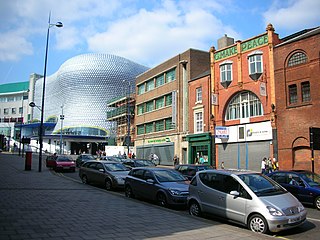
Digbeth is an area of central Birmingham, England. Following the destruction of the Inner Ring Road, Digbeth is now considered a district within Birmingham City Centre. As part of the Big City Plan, Digbeth is undergoing a large redevelopment scheme that will regenerate the old industrial buildings into apartments, retail premises, offices and arts facilities. The district is considered to be Birmingham's 'Creative Quarter'.
Liverpool St James station in Liverpool, England, was a railway station situated on the old Cheshire Lines Committee line from Liverpool Central between Central and Brunswick stations. The station was the penultimate station before Central terminal station competing with new electric trams. This line is now a part of the busy Merseyrail's Northern Line from Southport, Kirkby, Ormskirk branches to Hunts Cross. The station is located in a deep cutting between two tunnels at the junction of Parliament Street and St. James' Place, opposite St James' Church.

Cains was a brewery in Liverpool, England, founded in 1858 by Robert Cain. The company merged with Peter Walker & Son in 1921 to form Walker Cains. Peter Walker & Son had a large brewery in Warrington so sold its Liverpool brewery to Higsons in 1923. Boddingtons of Manchester took over in 1985. In 1990, Whitbread acquired Boddington's brewing operations and closed the brewery. It was reopened by GB Breweries, who became part of Bryggerigruppen in 1991, and in 2002 was sold to Gardener-Shaw for £3.4 million.
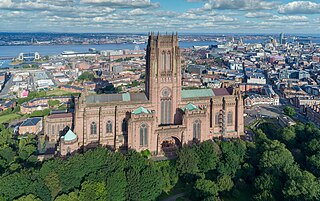
Liverpool City Region is a combined authority area in North West England. It has six council areas; five Merseyside metropolitan boroughs and the Cheshire unitary authority of Halton. The region had a population of 1,571,045 in 2022.
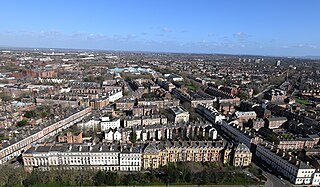
Canning is an area on the eastern edge of Liverpool city centre, England, characterised by almost entirely residential Georgian architecture. Parts of the district are included in Liverpool's Knowledge Quarter. It borders the rest of the Knowledge Quarter to the north, the district of Toxteth to the south, Edge Hill to the east and Ropewalks, Chinatown and the Baltic Triangle to the west. The area takes its name from one of its principal thoroughfares, Canning Street, which is named after George Canning, (1770–1827), a British politician who served as Foreign Secretary and, briefly, Prime Minister.

Headbolt Lane is a railway station in Kirkby, Merseyside, England, which opened on 5 October 2023.

The Pride Quarter, also known as the Stanley Street Quarter, Liverpool Gay Quarter or Village, is an area within Liverpool City Centre, England. It serves as the main focal point for Liverpool's lesbian, gay, bisexual and transgender community. The quarter is made up of mixed use developments including residential blocks, hotels, bars, nightclubs and various other businesses, many of which cater for the LGBT community. Aspects of the annual Liverpool Pride are also held in and around Stanley Street.
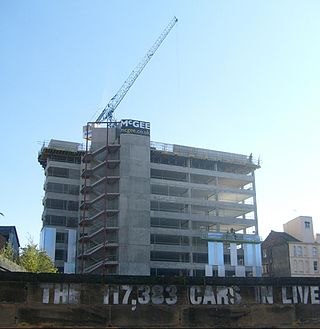
Central Village is a shopping, leisure, commercial and residential development that is currently under construction in Liverpool, England, United Kingdom. The complex is being built over Liverpool Central railway station, the UK's busiest underground station outside London. The core of the project is two high rise blocks of 25 and 20 floors linked by a 9-storey residential and commercial podium and two nine and five storey buildings for residential, hotel and commercial use. The development is by Merepark and is predicted to cost roughly £160 million. It is one of a number of ambitious projects to take place in Liverpool city centre in the early 21st century - other developments being Liverpool One, King's Dock, Prince's Dock, Lime Street Gateway, Metquarter and developments in the Commercial District. The proposed development includes the famous Lewis's department store building. Besides the residential, commercial and leisure aspects of the development, there will also be a number of office buildings and a large QPARK multi-storey car park - which will be the first part of Central Village to be completed in 2011. Planning permission was granted for the project by Liverpool City Council in May 2009, and final approval was given for construction of the entire complex to commence in February 2010. The entire Central Village scheme was due for completion in 2015 however is still to be completed due to a series of delays.

The economy of Liverpool encompasses a wide range of economic activity that occurs within and surrounding the city of Liverpool, England.

Steven Philip Rotheram is a British politician serving as Mayor of the Liverpool City Region since 2017. A member of the Labour Party, he was Member of Parliament (MP) for Liverpool Walton from 2010 to 2017.

Liverpool city centre is the commercial, cultural, financial and historical centre of Liverpool and the Liverpool City Region, England. Different definitions of the city centre exist for urban planning and local government, however, the border of Liverpool city centre is broadly marked by the inner city districts of Vauxhall, Everton, Edge Hill, Kensington and Toxteth.

The Liverpool Cruise Terminal is a 350-metre-long (1,150 ft) floating structure situated on the River Mersey enabling large cruise ships to visit without entering the enclosed dock system or berthing mid-river and tendering passengers ashore. The terminal was officially opened on 21 September 2007 by the Duke of Kent when the Queen Elizabeth 2 berthed at the terminal. The current terminal is composed mainly of a floating landing stage, with a small passenger terminal building, but a larger terminal is planned by the new operators Global Ports Holding.
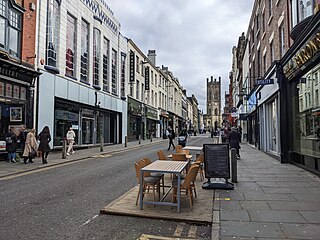
RopeWalks is a district of Liverpool city centre bounded by Hanover Street to the north-west, Lydia Ann Street to the west, Roscoe Street to the east and Back Bold Street to north-east.
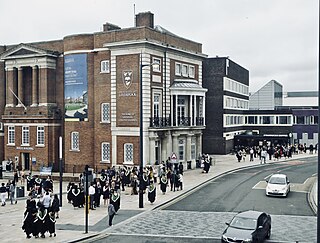
The "Knowledge Quarter" is an area of Liverpool city centre covering 450 acres, incorporating the vicinity around London Road, Islington, the so called 'Fabric District', Paddington Village and part of Canning.

The Granby Four Streets is an area in Toxteth, Liverpool, England, comprising four streets at the tip of a triangle near the Grade II* listed Princes Park. The streets, designed by Welsh architect Richard Owens and built by Welsh workers during the late 19th century are Beaconsfield Street, Cairns Street, Jermyn Street and Ducie Street. A fifth street, Granby Street, connects the four streets together and mostly contains commercial units.
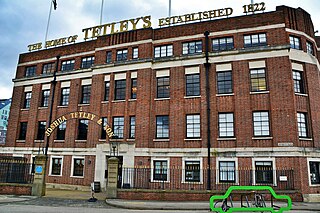
Aire Park is a planned 24 acres (9.7 ha) mixed-use development in Hunslet, south of the city centre of Leeds, West Yorkshire, England. It is being developed by the international real estate organisation Vastint, and will mostly occupy the abandoned brownfield site of the former Tetley's Brewery. It is named after the River Aire, which flows nearby.
Liverpool Baltic railway station is a proposed station in Toxteth, Liverpool, which would be built on the site of the former St James station, which closed in 1917. Construction is expected to start in 2025, and the station would be open around three years later.























